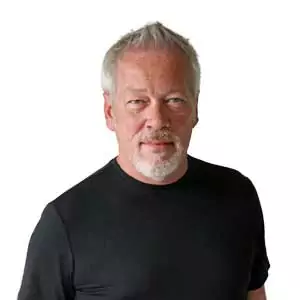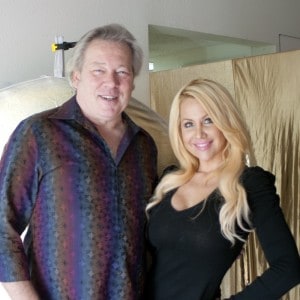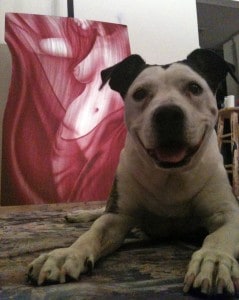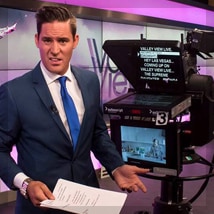Video: 42:08
June 27, 2025
The Las Cruces Museum of Art Virtual Artist Talk with A.D. Cook. Hosted by Bryan Lee, Museum Curator of Education (Art).
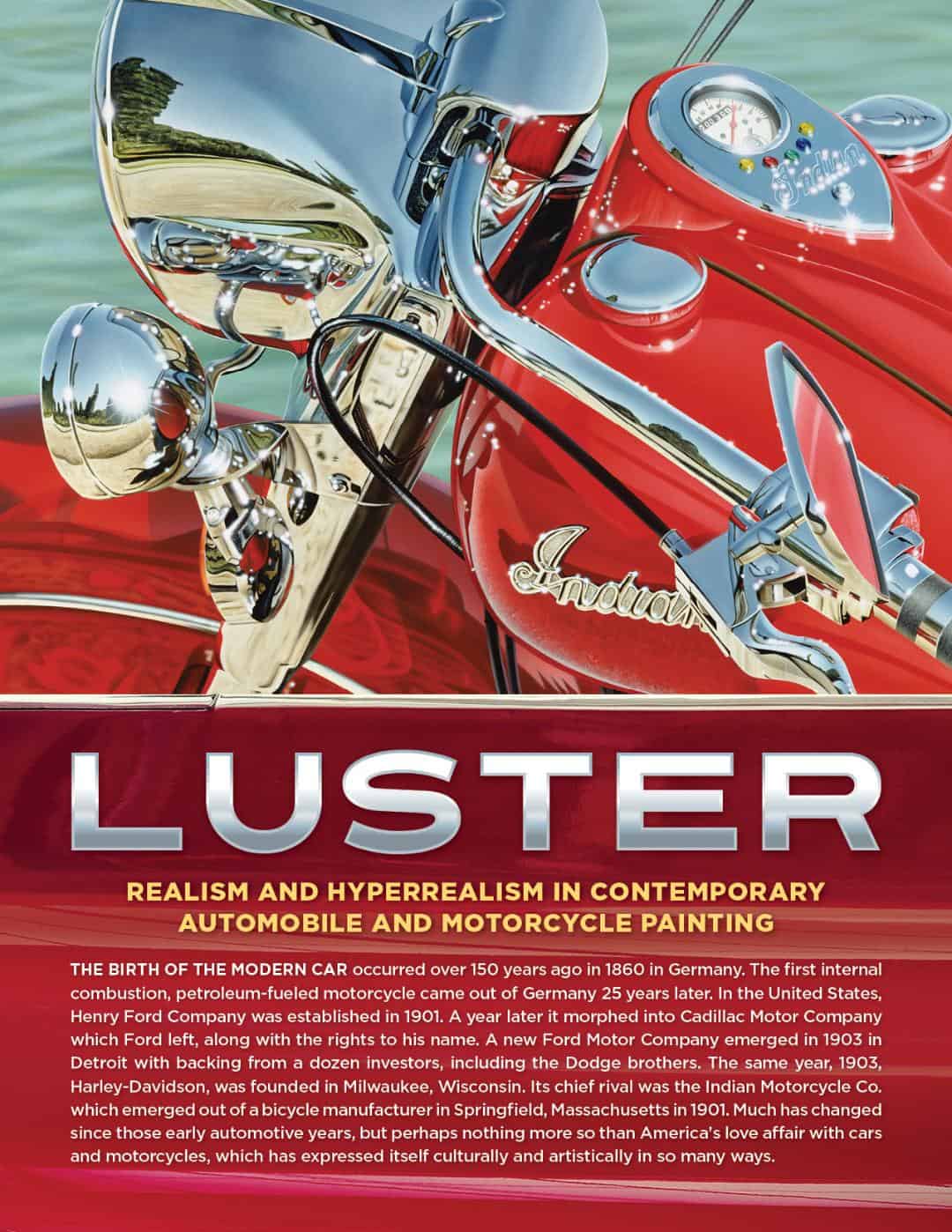
BRYAN — Well, hello, everyone, good morning, good afternoon, good evening, wherever you’re tuning in from. My name is Bryan Lee. I’m the arts educator at the Las Cusus Museum of Art. And thank you so much for joining us today for our virtual artist talk with A.D. Cook. So A.D.’s artwork is featured in LUSTER: Realism and Hyperrealism in Contemporary Automotive and Motorcycle Paintings here at the Las Cusus Museum of Art. It’s on display now through Saturday, August 16th. David J. Wagner LLC produced the exhibition. It’s been traveling around the country since 2018. And this is the last stop on the tour. If you’re interested in checking out the exhibit, we encourage you to visit the museum. We’re open Tuesday through Friday, 10:00 to 4:30, and Saturday, 9:00 to 4:30.
If this is your first time joining us for one of our Zoom presentations, you may notice that you don’t have access to the camera. If you’d like to ask a question for A.D., please type it into the chat box or use the Q&A feature. We’ll be monitoring that as we progress through the program, and we’ll address those issues at the end. Today’s presentation is being recorded, and we will post it on our museum’s Facebook page sometime next week, hopefully. That’s Facebook.com/LCMuseums, in case you’d like to watch it again, share it with your friends and family, or do whatever you’d like. Before we begin, let me introduce A.D. to you.
Forever an artist, A.D. started drawing early and has explored a variety of creative media and techniques over his lifetime. The artist’s original paintings are featured in magazines and books as masterworks. His artworks are also exhibited in national museums and galleries from Key West to Hawaii and have been featured as a guest artist and speaker at the Art Expo in New York City and Las Vegas. In the spring of 1989, A.D. accepted the position with Hollywood Entertainment and Hollywood Video stores in Portland, Oregon, to create dozens of large-scale hand-painted murals of movie stars and celebrities for the growing retail giant. Five years later, A.D. left Hollywood Video and formed a successful graphic design and print brokerage firm in Portland, Oregon’s Pearl District. During that period, he began producing a series of realistic paintings of iconic American motorcycles and abstract artworks while managing the design firm. In 2004, he created the first of many life-size, realistic fine art nudes on specially prepared canvases and metal, which he represented and sold in art galleries across the country. A.D.’s creative imagery breaks free from traditional art forms, leaving collectors marveling at the power, beauty, and detail of his artwork. The very nature of his art provides a lifetime of lasting enjoyment and increasing value for his collectors.
He’s been featured in Airbrush Action magazine, Airbrush Magazine, American Art Collector, America’s Sports Car Magazine, Art and Beyond, Easy Riders, Las Vegas City Life, Las Vegas Weekly, Lavo, Models Mania, Quick Throttle, and The Ultimate Airbrush Handbook.
A.D. currently resides and is tuning in to join us from his home in Phoenix, Arizona. A.D., thanks so much for being here today. How are you doing?
A.D. — I’m doing great. Bryan, thanks for having me. How are you doing?
BRYAN: Good. Good. We appreciate your time and joining us today. So, for our guests here, what we’re going to do is we’re just gonna go over like A.D.’s career, and he’s done lots of other kinds of paintings and artworks besides what you might see here in the Museum of Art with the automobiles and motorcycles. So, I’m going to pop open a PowerPoint presentation that we’ve prepared. All right. So, we’ll just get started with something. Let’s see. Oops. Let’s go to the next slide. There we go. This is one of A.D.’s paintings that he completed relatively recently. If you joined us on the evening of June 6th during our artist reception here at the museum for the Luster exhibit, A.D. brought this painting with him to display in the gallery. So, A.D., can you tell our audience a little bit about this piece and what we’re looking at here?
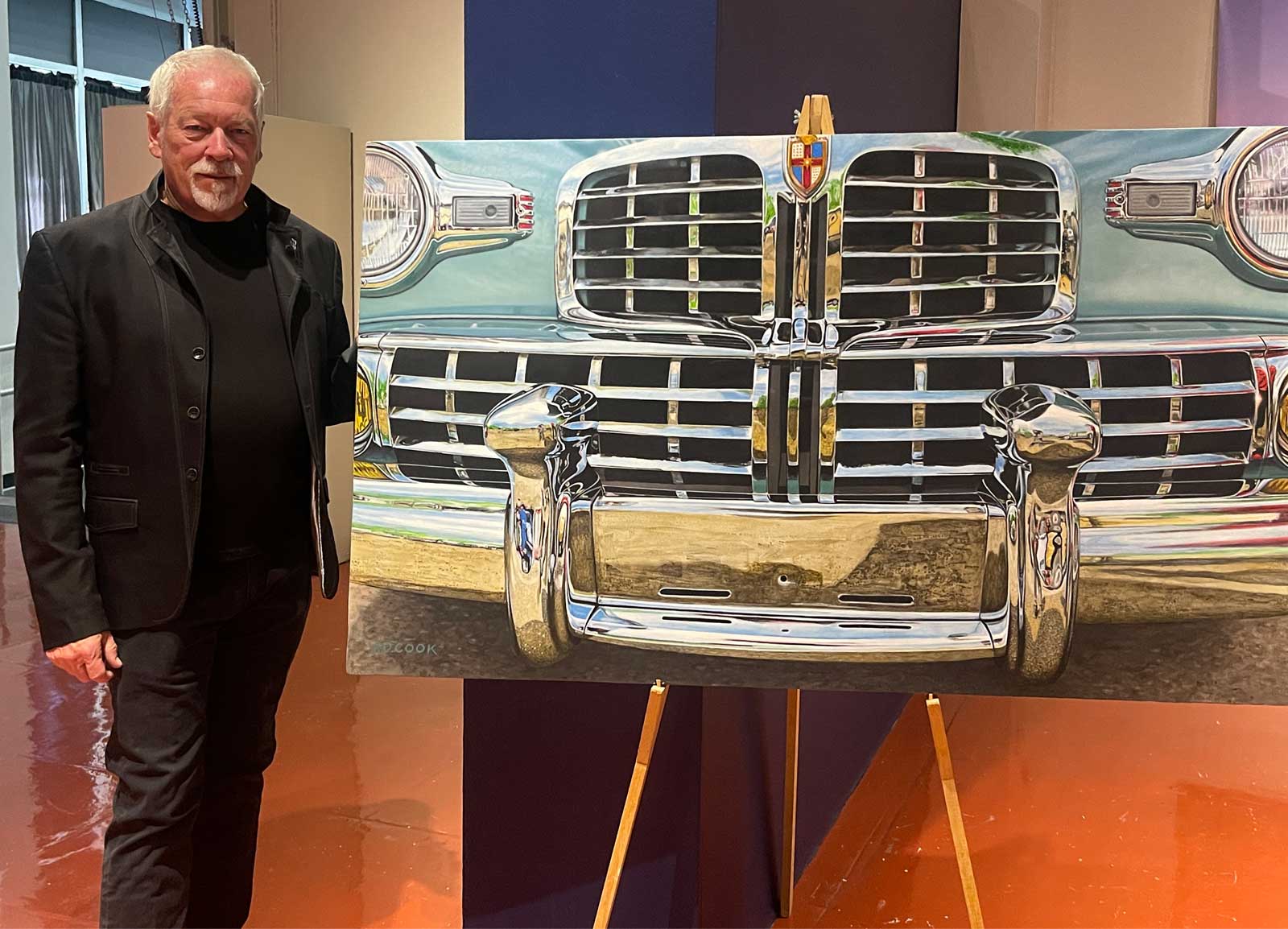
A.D. — Thank you. Yeah, this was a blast to paint. It’s a three-foot-by-five-foot painting of a 1948 Lincoln Continental. I attend many car shows, so every once in a while, I come across one that stops me, and this one was that. I love the miles of chrome. And so, I’ve been working on this piece off and on for about six months or so. It’s signed, but it’s not 100% finished. I’m not sure if they ever will, but there are a few little tweaks – probably no one will notice but me – but I just fell in love with the car and all the chrome. It’s massive. This car is huge.
BRYAN — So you mentioned to us previously that you work a lot from photo references. So, like for example, for this piece, did this car belong to someone you knew, or did you see it at a car show, or where?
A.D. — It was at a car show, and I take cameras with me to every car show. So, I only paint from my photo reference for everything I do. So yeah, it was one of those shows where every time you show up, there’s a couple hundred cool cars. This was one of them. And I kind of wish I’d gotten the guy’s name because I haven’t seen the car since I want to show him this painting that he doesn’t know exists.
BRYAN — Well, that would be a big surprise. Very nice. So, you mentioned it took, started this over six months ago. Do you work on multiple projects simultaneously, or do you start one and work on it until it’s completed? How does that process work for you?
A.D. — Well, I like to dabble with a lot of different things. I have a couple of small sculptures in progress, and I draw every day, which involves creating different pieces, including little sketches, and then I build websites. So, I usually have a lot of other projects going, but one centerpiece project. And that’s what this is, kind of the one I do everything else to buy time to work on this.
BRYAN — Right. Cool. Okay, let’s see. This next painting, AMERICA, is featured in the Luster exhibition. So, you can check this one out here at the museum if you stop by. So, how about this one? It is very, very iconic. So, what do we have here?
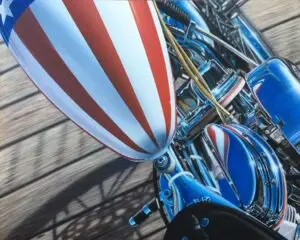 A.D. — It’s very iconic. Yes, everyone knows this motorcycle is Captain America from the Easy Rider movie back in the 1960s. I have a collector who owns a few of my motorcycle paintings, and he owns a Harley dealership in Tacoma. And one day he said, “Hey, we’re going to sell our Captain America bike, but we want something to remember it by. So, can you do a painting?” And I flew up to Tacoma with my camera, spending a couple of days with him, pushing his bike all over town. I took probably five or six hundred photos, and I painted from one of them. It’s four feet by five, and it was first showcased at the Sturgis motorcycle rally. And ironically, I delivered the painting to my collector, and about a week later, David asked if he could borrow it for Luster. So, the collector hadn’t even brought the item into his home yet.
A.D. — It’s very iconic. Yes, everyone knows this motorcycle is Captain America from the Easy Rider movie back in the 1960s. I have a collector who owns a few of my motorcycle paintings, and he owns a Harley dealership in Tacoma. And one day he said, “Hey, we’re going to sell our Captain America bike, but we want something to remember it by. So, can you do a painting?” And I flew up to Tacoma with my camera, spending a couple of days with him, pushing his bike all over town. I took probably five or six hundred photos, and I painted from one of them. It’s four feet by five, and it was first showcased at the Sturgis motorcycle rally. And ironically, I delivered the painting to my collector, and about a week later, David asked if he could borrow it for Luster. So, the collector hadn’t even brought the item into his home yet.
BRYAN — Cool.
A.D. — Seven years later, he might get a chance to see it.
BRYAN — So, out of all those hundreds of photographs you took, was there a specific reason you picked this one? We’re looking at it from a top-down view, but at a slight angle.
A.D. — So, right, it’s on its kickstand. So, it’s just parked there on a pier in Tacoma, an old wooden pier. I wanted that feeling of being on top of it, like you were straddling it, and because the bike is big, the painting is big; it just dominated the space. So rather than looking at it, you’re part of it.
BRYAN — And I’ve noticed that in the works of many of the other artists featured in Luster, we’re never looking straight on at one. I’m speaking specifically about motorcycles; we’re not looking straight at them. They’re at like an angle from the underside or the back. I was curious about the composition choice in seeing your paintings in this way. And you had mentioned that soon after finishing it, David Wagner asked to borrow it. So, is that how you were introduced to David and the Luster exhibit, just kind of reached out to you and just wanted to work with you on this? Is that how it went?
A.D. — Yeah, well, one of the other artists in the show suggested my inclusion, which was awesome. And so David just called me out of the blue, introduced himself, and I was coming back from a big show in Sturgis, and he said, We’d like to include you in this show, and I didn’t have any pieces. I thought, ‘They’re all sold.’ I don’t have anything. And I pushed him off because I didn’t know he was real. Sometimes it seems that everybody calls and says, “We’d like to borrow a bunch of paintings” or something similar. And so I pushed him off a little bit. And then he called back, and I said again, I don’t have anything, and he said, “Well, why don’t you think about borrowing them from their collectors?” I’m like, “I’ve never really thought about borrowing paintings from my collectors.” But I thought about it, and then when he called the third time, I thought, “Well, I better take him seriously.” So, I called my collectors, and they were excited to be included. That’s essentially how the paintings are included. I don’t own any of the paintings in the show aside from this piece behind me, which I’m still working on. Everything else throughout the show was borrowed.
BRYAN — Well, here we are, seven plus years later, and over a dozen venues of Luster around the country. I’m sure thousands have seen your paintings of people in this relatively short time frame.
A.D. — So yeah, it’s been an enormous honor. You are the twentieth museum on the tour.
BRYAN — Twenty, wow.
A.D. — Yeah. Since 2018.
BRYAN — Yeah. If you’re interested in seeing where this exhibit has traveled, A.D.’s got the information on his website at ADCook.com. And then we have another one of your paintings here in Luster. Could you tell us a little bit about this one?
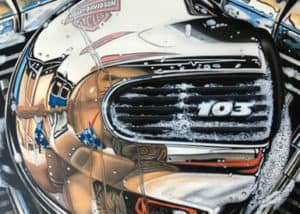 A.D. — Sure, DREAM 103 has got a little interesting backstory. I was asked if I would like to participate in a show at Sturgis, and the theme was “Skin and Bones.” So it was all about tattoos, for the skin, and the bones were the motorcycles. And so I didn’t have anything, and I said I don’t have anything that fits that. I have artwork of motorcycles and artwork of people with tattoos, but I don’t have anything that combines both. But how long until you need it? And he said about a month. And so I jumped right on it. It was the Fourth of July weekend. I took my camera to the Harley dealership, where there was a bikini bike wash booth. You could see the girl reflected in the motorcycle. I asked if she would like to model, and I had a model release form with me, which she signed. I took pictures and went off to do this painting, then shipped it to Sturgis. That was the one right before David contacted me. And what’s fun about this painting is that people don’t realize there are 103 little skulls hidden within all those silk bubbles. So there are 103 hidden. I might have lost count, but to the best of my effort, there are 103. Yes, so there might be 203. Some people told me they’ve seen more than 103.
A.D. — Sure, DREAM 103 has got a little interesting backstory. I was asked if I would like to participate in a show at Sturgis, and the theme was “Skin and Bones.” So it was all about tattoos, for the skin, and the bones were the motorcycles. And so I didn’t have anything, and I said I don’t have anything that fits that. I have artwork of motorcycles and artwork of people with tattoos, but I don’t have anything that combines both. But how long until you need it? And he said about a month. And so I jumped right on it. It was the Fourth of July weekend. I took my camera to the Harley dealership, where there was a bikini bike wash booth. You could see the girl reflected in the motorcycle. I asked if she would like to model, and I had a model release form with me, which she signed. I took pictures and went off to do this painting, then shipped it to Sturgis. That was the one right before David contacted me. And what’s fun about this painting is that people don’t realize there are 103 little skulls hidden within all those silk bubbles. So there are 103 hidden. I might have lost count, but to the best of my effort, there are 103. Yes, so there might be 203. Some people told me they’ve seen more than 103.
BRYAN — So yeah, at the artist reception, several of the other artists and I were looking at, and I think we found nine when we counted, where we’re just like my gosh. It’s like, obviously, we see them right there, and the bubbles, and you have to look closely at it.
A.D. — Yeah. Some of them are small and scattered throughout the area. Some are upside down, and there are bubbles to the left and way up on the top, but they’re all over. It was fun.
BRYAN — So, so do you incorporate little hidden details and Easter eggs like these in all of your works, or just like certain ones?
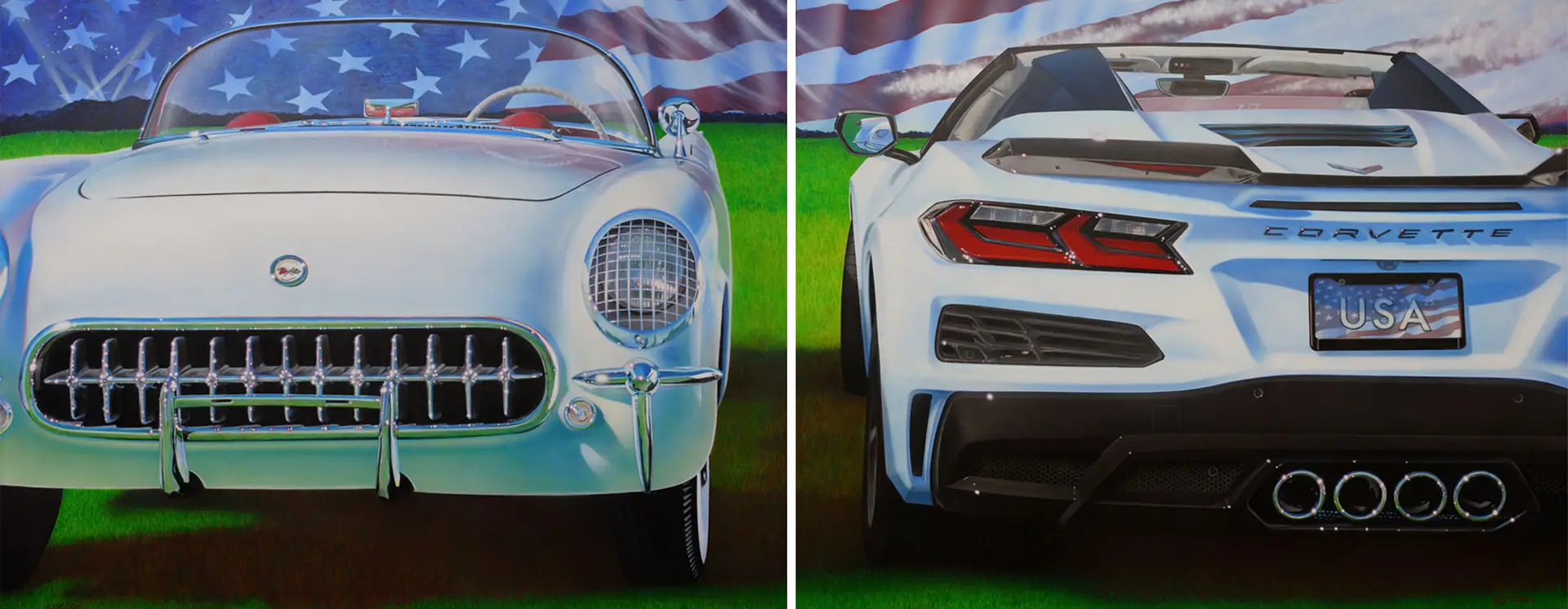
A.D. — In pretty much everything. I think that the difference between photorealism and hyperrealism is that you can have the ability to play more with hyperrealism. The piece I have behind me features the continental United States hidden in the bumper, along with numerous people, cars, and other small details. The pieces at the Corvette Museum feature a variety of items, including the Hollywood Video mountains, as I drove a Corvette during my time at Hollywood Video. You know, there are reflections of different parts of the car, VINs, and other details that I can include without being too campy or cartoony.
BRYAN — So, yeah, that’s something I wanted to ask, too, about when painting a reflection, for example, like the model in this painting right here. Is this as accurate as you can from your photo references, or do you like to tweak it, especially when you’re drawing reflections, like of people, for example, do you tweak it to kind of in your mind it might look right or a little bit better this way instead of what’s actually in the photo or…
A.D. — Always, yeah, always. The photo is a starting point for me — it’s not the end of the process. My goal isn’t to copy a photo but to be inspired by it, so like the picture that’s on your PowerPoint now. You see, she didn’t have a tattoo that said “Dream,” so I added that.
BRYAN — Oh, okay.
A.D. — And then she had the tattoos on her left arm with the full sleeve, but I might have embellished to simplify some of that.
BRYAN — And are you like a regular attendee up at Sturgis, or is it just a every once in a while sort of thing?
A.D. — I’ve been there a few times, but not in a long time. Okay. I went through a total Harley-Davidson phase where I owned a lot of bikes and built a few show bikes, that sort of thing.
BRYAN — Cool. And do you have any, if you don’t mind me asking, do you have any tattoos yourself? Do you have any tattoos of your own? Are you into the tattoo culture?
A.D. — I have a tattoo. It starts at my elbow and goes to my big toe. No, I’m just kidding. I have a tattoo on my shoulder here of a phoenix because I’m from Phoenix. So, I think I’m one and done with tattoos for me. It was a good experience, but I’ve been there, done that.
BRYAN — Nice.
A.D. — It’s pretty big, though. It’s a half-sleeve, half-shoulder design.
BRYAN — Oh, okay. So, you’ve also created photorealistic fine art nudes, and you mentioned that you’ve been doing so for over a decade. This is just an example. So, can you tell us a little bit about your thoughts when you’re painting your nudes and your figures in this regard?
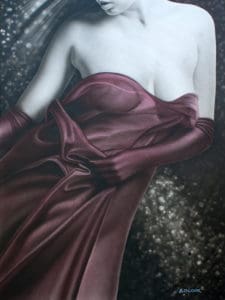 A.D. — Sure, yeah. This piece is part of my Pearl series. So the paints are all pearls and metallics. It changes with the light, as different lighting conditions hit it, and so on. This is a model, Jess, that I worked with years ago, and I’ve done several paintings of Jess. She was such a great model. It’s PREMIER. I was living in Vegas, and I just had to catch that Vegas vibe, and that’s really what this piece is about. It’s just, everybody gets all dolled up and dressed up and whatnot for the night on the town. And this is a little bit of that and pays homage to that, anyway.
A.D. — Sure, yeah. This piece is part of my Pearl series. So the paints are all pearls and metallics. It changes with the light, as different lighting conditions hit it, and so on. This is a model, Jess, that I worked with years ago, and I’ve done several paintings of Jess. She was such a great model. It’s PREMIER. I was living in Vegas, and I just had to catch that Vegas vibe, and that’s really what this piece is about. It’s just, everybody gets all dolled up and dressed up and whatnot for the night on the town. And this is a little bit of that and pays homage to that, anyway.
BRYAN — And so you’d mentioned to us at our previous talk that you primarily work with acrylic paints, but you’ve also done airbrushing and used automotive paints. And this one, you mentioned specifically the metallics in here. Do you choose different kinds of paints and tools specifically for the types of projects you’re working on, or is it more about what you feel would complement your idea?
A.D. — Well, I like to mix it up and play with different tools. This piece is almost entirely airbrushed.
BRYAN — Oh, okay.
A.D. — Premiere, almost entirely, whereas the car piece behind me has hardly any airbrush. It has hundreds of hours of painting with a paintbrush and maybe a few hours of airbrushing to add a little sizzle here and there. So, it just depends on what I’m painting. You know, if it’s soft stuff like skies and clouds and whatnot, I’ll probably divert to an airbrush. And if it’s something else, it just depends on how I feel. It’s when I’m in the studio that I like to guide the process, at least for the moment.
BRYAN — Nice. Yeah. Specifically, I noticed the soft edges. So, I thought there might have been some airbrushing involved, but I didn’t want to assume because I’ve seen artists paint with just a brush for the entire painting, or they use a combination of tools and supplies. So, very nice.
A.D. — Yeah, and these are all life-size, the figurative pieces. They’re pretty big. I like the airbrushed look for representational art, though.
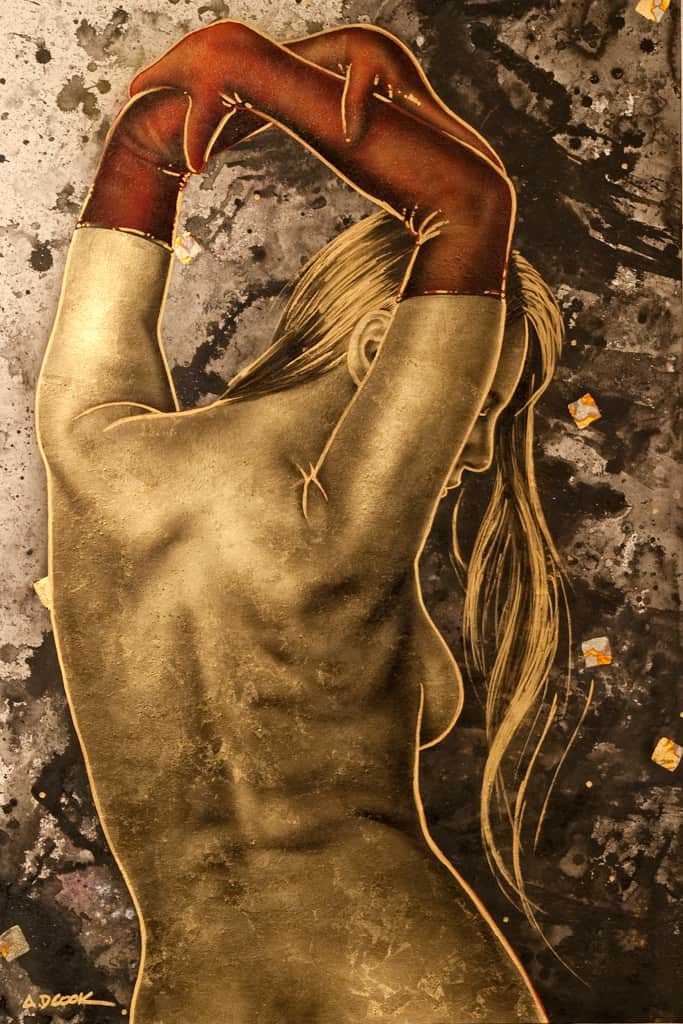 BRYAN — So, when you’re working with models, like for for your previous painting, you mentioned you just met someone who happened to be at that car wash, but for your for your fine art nude series, do you like did you work with like a modeling agency or the people you know or how do you get in contact with people who are willing to pose for your photo references, I should say?
BRYAN — So, when you’re working with models, like for for your previous painting, you mentioned you just met someone who happened to be at that car wash, but for your for your fine art nude series, do you like did you work with like a modeling agency or the people you know or how do you get in contact with people who are willing to pose for your photo references, I should say?
A.D. — Usually, through a website called Model Mayhem, which has been around now for about twenty years. They have about a million members, and models post what they’re comfortable with, what they’re looking for, and their rates. This allows them to view my profile, see my work, and decide whether they want to work with me. And when Model Mayhem was starting, around 2004, they called me and said, “We’re building a website and we’d like to include you.” So, I’m number 531 out of a million. So, being in Vegas, you get a lot of mods that travel through Vegas, and so they would ping me and say, “Hey, I’m coming through Vegas.” And if it were someone I wanted to work with, I would reply, and if everything made sense, I’d do a shoot with them. Still, I generally work with professional models, unless it’s a commission, such as a request for a portrait of oneself or a similar project.
BRYAN — And do you get a lot of commissioned art pieces from clients or friends, or like that?
A.D. — I don’t know about a lot — a few here and there on occasion. It just depends. Comes and goes in waves like the whole art thing, you’re either busy, feast, or famine. And the artwork is for the artist. However, I always have something going on; nonetheless, the piece behind me is not a commissioned one. I’m just doing that for myself, and someday it may find a home.
BRYAN — Okay. So, this one’s painting with another model, but has a profound meaning to it. So, can you tell us what we have here in HOLD THE LINE?
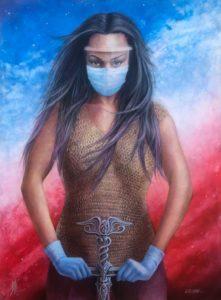 A.D. — I created this with Beti Kristoff. You can see it’s collaborative. She did the vast majority of this. I helped with a few things. I did the model shoot. Beti did most of the painting, and then I went in with an airbrush to complement and assist her with a few details here and there, giving it a blended look that incorporated a mix of media. But, this painting is probably three-quarters Beti and a little bit of my help. And, but again, one of the models that came through my studio was a professional model. When I shot her, she didn’t have any of the mask, the goggles, the gloves, or any of that. When COVID happened, Beti and I both felt like we wanted to honor the nurses who were working so hard and getting so little in return. This was intended to show that these women are warriors. So, it’s a dedication piece.
A.D. — I created this with Beti Kristoff. You can see it’s collaborative. She did the vast majority of this. I helped with a few things. I did the model shoot. Beti did most of the painting, and then I went in with an airbrush to complement and assist her with a few details here and there, giving it a blended look that incorporated a mix of media. But, this painting is probably three-quarters Beti and a little bit of my help. And, but again, one of the models that came through my studio was a professional model. When I shot her, she didn’t have any of the mask, the goggles, the gloves, or any of that. When COVID happened, Beti and I both felt like we wanted to honor the nurses who were working so hard and getting so little in return. This was intended to show that these women are warriors. So, it’s a dedication piece.
BRYAN — And have you done like other paintings or other art pieces that focus on current events, or was this more like a one-off project?
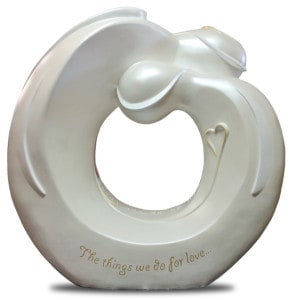 A.D. — Yeah, I don’t usually get into current event stuff. I’ve done a few pieces over the years to help, such as St. Jude’s Children’s Hospital or similar organizations. Still, they’re typically around an event, like a charity drive or a benefit event. But I don’t get too much involved in the news in my artwork. I like to create timeless pieces.
A.D. — Yeah, I don’t usually get into current event stuff. I’ve done a few pieces over the years to help, such as St. Jude’s Children’s Hospital or similar organizations. Still, they’re typically around an event, like a charity drive or a benefit event. But I don’t get too much involved in the news in my artwork. I like to create timeless pieces.
BRYAN — So the pandemic was, I mean, it was unbelievable for everybody, and everyone had their circumstances, so what was it like for you, like when COVID happened and everything shut down? Like, did that disrupt any of your art at all, or was it just, I’m in the studio painting, so we see how this goes, or anything?
A.D. — Yeah, it didn’t disrupt the art [creation] as much as it did the art shows. I was in Vegas, performing in numerous shows, including significant luxury events with Lamborghini and Aston Martin, as well as shows on the Strip. And then the whole Las Vegas strip got shut down and all the venues for so long, and I’d say that was the most significant disruption. It didn’t involve the art because my studio was at home, and I do graphic design, so I didn’t have to worry about any of that kind of stuff. However, in terms of getting out and connecting with people, showing the art, and so on, it put a halt to that pretty quickly.
BRYAN — Yes, here at the Las Cruces Museums, we had to adapt to being closed to the public. We had several art exhibits and cultural events here at the Museum of Art and the Brand Cultural Center. Since the public was not allowed to visit the museum in person, I often brought my laptop and camera to the room and conducted virtual tours for people. It’s like this: we show them what we have, and then they go across the street to their museum, and then we show them what’s over there. And, yes, our institutions were closed to the public for over a year before we were allowed to reopen with the safe protocols in place at the time. But yeah, it was a crazy time.
A.D. — Yeah, I remember even with the Luster exhibit, a few of the museums that it was at, hosted at, had the same thing, you know, weird hours, limited people, and the masks and stuff like that. So, that was the most significant impact, I think.
BRYAN — So, this series of work is some of my favorites I’ve seen of yours, A.D. You were significantly involved with Hollywood Video for several years, serving as their resident mural artist and creative director for the brand.
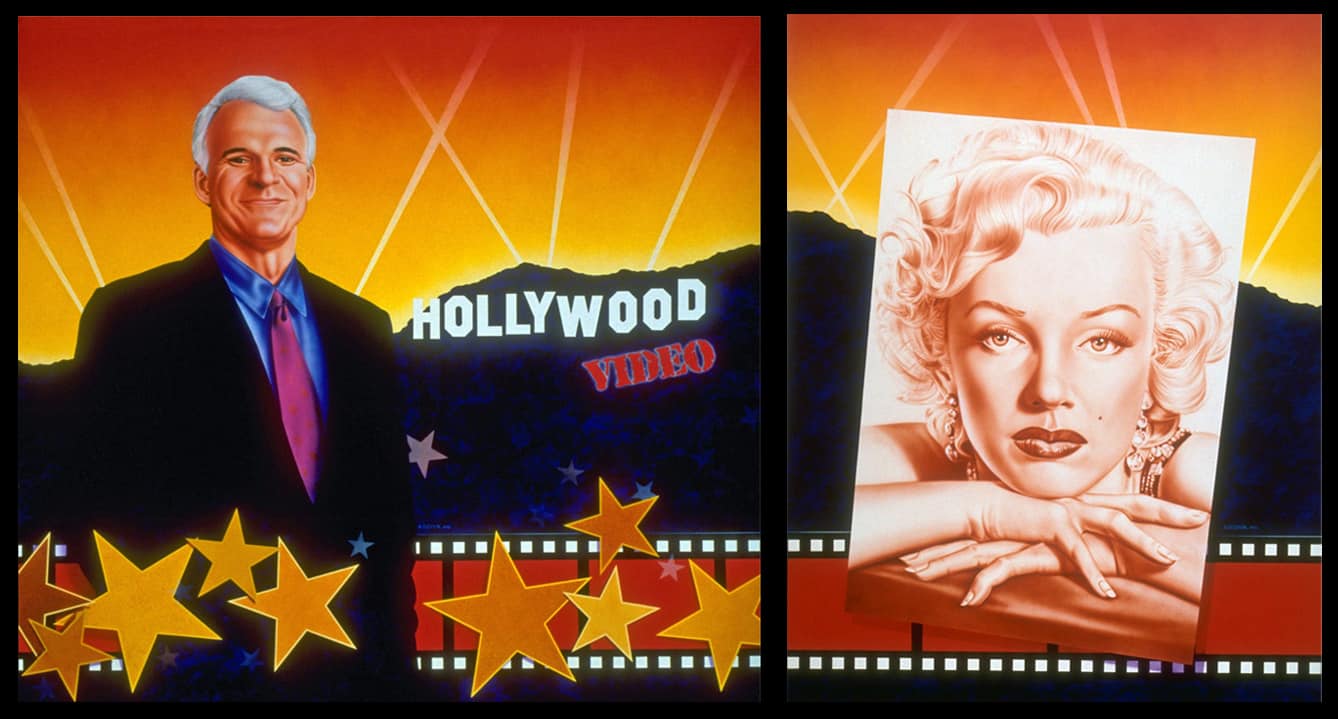
A.D. — Yeah. Everything from before there was a Hollywood Video. I helped name it, designed their logo, ran their art department for five years, and painted all the murals. These are also among my favorites. These are big. They’re almost ten feet tall and about fifteen feet across for the two of them. And I split because the wall with Maryland was pushed back about a foot, at the buildout at the construction site. I used to paint murals for each specific store, tailored to each location. And these were painted for the Beaverton, Oregon, store back in the day. They’re very special to me. I enjoyed creating them. I’m a massive fan of Steve Martin. And, Marilyn, which I painted probably a dozen times while I was with Hollywood Video — lots of Marilyns, Elvis murals, Bogarts, and James Deans.
BRYAN — So, when you were creating the murals for the stores that were opening, because for those who are unfamiliar, Hollywood Video got a start in Oregon and the Greater Pacific Northwest before they branched out throughout the country. So, did you decide which imagery to use for each mural? For example, celebrities or any aspect of pop culture. It was simply a matter of personal preference for everyone.
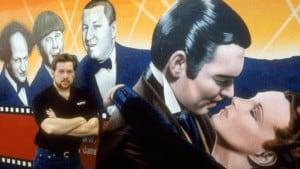 A.D. — Totally. They just let me run wild. It was great. Some days, I’d be like I’d want to paint a JAWS mural or a TERMINATOR or whatever, and I would paint whatever I felt like. However, I tried to make it fit the store, and I wanted to strike a balance between classic and new. You know, like if I were going to do a Rambo mural, I’d make sure there’s a Bogart or a Frankenstein mural, or whatever. Some of the stores had hundreds of square feet of murals.
A.D. — Totally. They just let me run wild. It was great. Some days, I’d be like I’d want to paint a JAWS mural or a TERMINATOR or whatever, and I would paint whatever I felt like. However, I tried to make it fit the store, and I wanted to strike a balance between classic and new. You know, like if I were going to do a Rambo mural, I’d make sure there’s a Bogart or a Frankenstein mural, or whatever. Some of the stores had hundreds of square feet of murals.
BRYAN — So, how did your employment with Hollywood, Hollywood Entertainment, or Hollywood Video start? Were they looking for someone, or did they reach out to you specifically, or…
A.D. — It’s a funny story, thanks. I was looking for a video store in Portland to rent a movie for the night. My wife and I wanted to watch something and I was driving and I saw this huge video store on the off the side of the road there on 82nd, a pretty main road actually, and it said Home Theatre, and I went in there and its carpet was gray, its walls, ceiling, its racks, everything was just all gray. It didn’t have much color or design, except for a couple of movie posters pinned to the wall. And as I was joining to rent movies, the guy behind the counter said, “Hey, that’s a crazy signature, what do you do?” And I said, “Well, just a minute.” And I went out to the car and I grabbed my portfolios. I slung them out on the counter, and he said, “We’re going to open a couple of video stores, and we don’t know what they’re going to be called or what they’re going to look like, but we could use a guy like you.” And for the next five years, I worked at Hollywood Video.
BRYAN — Wow!
A.D. — It was quite a blast. Always answer the call. Just like with David, you never know.
BRYAN — You never know where an opportunity will strike. Wow, that’s cool.
A.D. — Yeah, it’s just one of those fun stories. Had I been there a different night and somebody else been behind the counter, there’d be no Hollywood Video. There’d be something else, but they wouldn’t look like that.
BRYAN — Well, like my hometown had one Blockbuster Video and one Hollywood Video, and they were powerful rivals. And although I tended to gravitate more towards Hollywood Video, at the time, in the nineties and the early to mid-twentieth century, at least in my opinion, Hollywood Video seemed to have a better selection of video games that I wanted to rent. I mean, compared to like Blockbuster, for example. So, I always went to the Hollywood Video store, but I don’t remember if our local store had a mural. I’m sure there was something on the walls, but since you had originally painted the murals on site and in location, as more and more stores were opening, especially outside the Pacific Northwest. So, what were your thoughts on replicating some of your murals to be put into more stores? Were you okay with that, or did you prefer to have these originals as much as possible?
A.D. — Well, we were growing so fast it was impossible to keep up with the originals. So, these two murals that you have in this slide, Steve Martin and Marilyn, and many others, after a while, I couldn’t paint on location. It just didn’t make sense for me to be at the store for three weeks or a month or whatever. And so we set up a large studio, and I would stretch a ten-foot-tall canvas, which I’d buy in a hundred-foot roll. I would stretch it on the wall, then prime it, sand it, and paint the mural on the canvas. After that, we would roll them up and take them to a large photo studio, where they would be photographed with an 8×10 view camera. That’s going back; you guys know the cameras with the bellows and stuff, and then they would make them into photo murals. So, this was before digital, so they were photos, giant, great big, basically like laminated wallpaper. It’s just the same with the film strip. I would paint them by hand in stores, but eventually, that became impossible. So, I created a continuous film strip for them to display around the stores and other similar items.
BRYAN — Oh, okay.
A.D. — We had to evolve.
BRYAN — Well, last winter, we had a large photography exhibit here at the museum, and the photographer, Butcher, loaned us one of his large, boxy cameras that he used to take his photographs. So, when you mentioned that, ‘Oh yeah, I know what that is,’ I knew what you were talking about.
A.D. — Yeah. So it’s very cool. Very, very few people do that anymore. It’s all digital now.
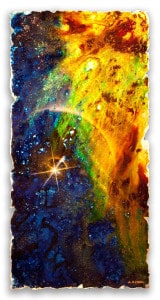
BRYAN — Yeah. Okay. And then we have the last photo for our presentation here. You’ve also created abstract artworks, and this, along with a few others I’ve seen of yours, really caught my attention for use in these color-shifting automotive paints.
A.D. — Yes, I use automotive urethanes on aluminum.
BRYAN — So, I was going to ask, was it your choice to use these particular kinds of materials, inspired by your work painting cars, or was it just, ‘Hey, this looks cool, maybe I’ll give this a try on a painting or two’?
A.D. — Yeah, as an airbrush guy, and I think a lot of airbrush guys go through this, but I painted a lot of motorcycles and stuff on cars, vans, and stuff very early on. I picked up an airbrush when I was in junior high school. My entire mode of operation was to paint anything, and over the years, I enjoyed experimenting with automotive urethanes. They’re very toxic and whatnot, but they also have qualities, transparencies, and color-shifting paints and candies that you can’t get anywhere else. And so, this piece, along with many others that I’ve done, is one of my favorites, by the way. However, I would take a power grinder and grind the aluminum. There are videos on my website, but I grind the aluminum so that it has a pattern, which also allows the paint to stick and adhere to it. This creates a textured surface that doesn’t appear super smooth, yet it still creates an illusion. So when you walk by them, they’re almost like holographs—and then pouring these different paints on them. And then this one has just a whisper of airbrush, the starburst, and the outer glow, and no two are the same. I did a ton of these, and every one of them is entirely different. That’s kind of what I love, the spontaneous aspect of them. I don’t do as many anymore, but they were they were fun for a while.
BRYAN — So, for like these metals that you’ve painted on, like in this one, for example, has the sort of ragged edge to it. Did the piece originally come like that when you received it, or did you say you ground it?
A.D. — You have to buy aluminum in sheets. I bought a four-foot by ten-foot sheet, and then we would cut it all into sections to whatever size I wanted for the artwork. And this one here, I call them my organic edges. And I would put a lot of extra time into just taking a power grinder and going around, then sanding and filing it so that it looks dangerous, but it’s not. However, I appreciate that one of the things I like about metal is that it’s not limited to a square, hard-edged surface. You can do all kinds of fun stuff with them. So, often with my metal pieces, I’ll break away a section or punch some holes in them, or do something to make them unique.
BRYAN — And this one captivated me because I like bold colors that pop out at you. So, when I saw this, I wanted to hear the story behind this one.
A.D. — Yeah, I kind of wish I hadn’t sold this one because I did like it. But it hung at a wine bar in Vegas for a while, and someone walked in and fell in love with it, so hopefully it’s still hanging in someone’s home. That was a long time ago. This piece is probably from 2008. I was going to say it’s been quite a while.
BRYAN — Yeah, I’ve seen some artists who use like car parts as their canvas, like the side panel off a car or a wheel rim or something like that, doing all kinds of stuff. So, sometimes I don’t even know what I’m looking at until I take a closer look at the shape and go, “Oh.”
A.D. — I love that people repurpose stuff like you and I were talking a little bit before the start, that your dad is maybe building a rat rod, right? And I love that because you’re taking all these old pieces that in and of themselves are garbage, broken wrenches and whatever, and somehow you’re turning them into a piece of art that rolls. So, I’m a big fan of that. Repurposing, reclaiming, I guess, right?
BRYAN — Okay. That was all the slides I had in my PowerPoint presentation here. So, if anyone has questions for A.D., please take this opportunity to type them into either the chat box or the Q&A feature. So we’ll see that pop. While we’re waiting, A.D., I was curious, you had finished the Continental behind you. Are you currently working on another project, or is anything in the works for you?
A.D. — I have a few photos that I’ve been going through, seeing what I like. I have a couple of concepts that I want to explore. I’m probably going to stick with something car-related, but I also have someone who’s talking about doing an airplane commission.
I’m looking forward to that, as I love painting skies, which would be a fun challenge. I have about half a dozen half-finished things in the studio, so I’m just bouncing around until something pins me down.
BRYAN — Cool. Right on. So, we have our question popping in here. What’s your favorite car? That’s a broad question.
A.D. — That is a broad question. I have a lot of favorite cars, but which one should I drive or paint? I’m a Corvette guy at heart, so I have two paintings at the National Corvette Museum. So, probably, if I were going to get something fresh tomorrow, it would be a quarterback. And don’t ask me which model, because I have a favorite from each generation, but I love the mid-sixties convertibles a lot. I have a lot of favorite cars. You know, my buddy ran Lamborghinis in Vegas, and so I drove everything, Lambos and Rolls-Royces, and this and that, but I’m an American car guy at heart.
BRYAN — Nice. So, aside from your two paintings here in Luster at the Las Cruces Museum of Art, are any of your other paintings or other art pieces currently on display anywhere around the country or the world that you know of?
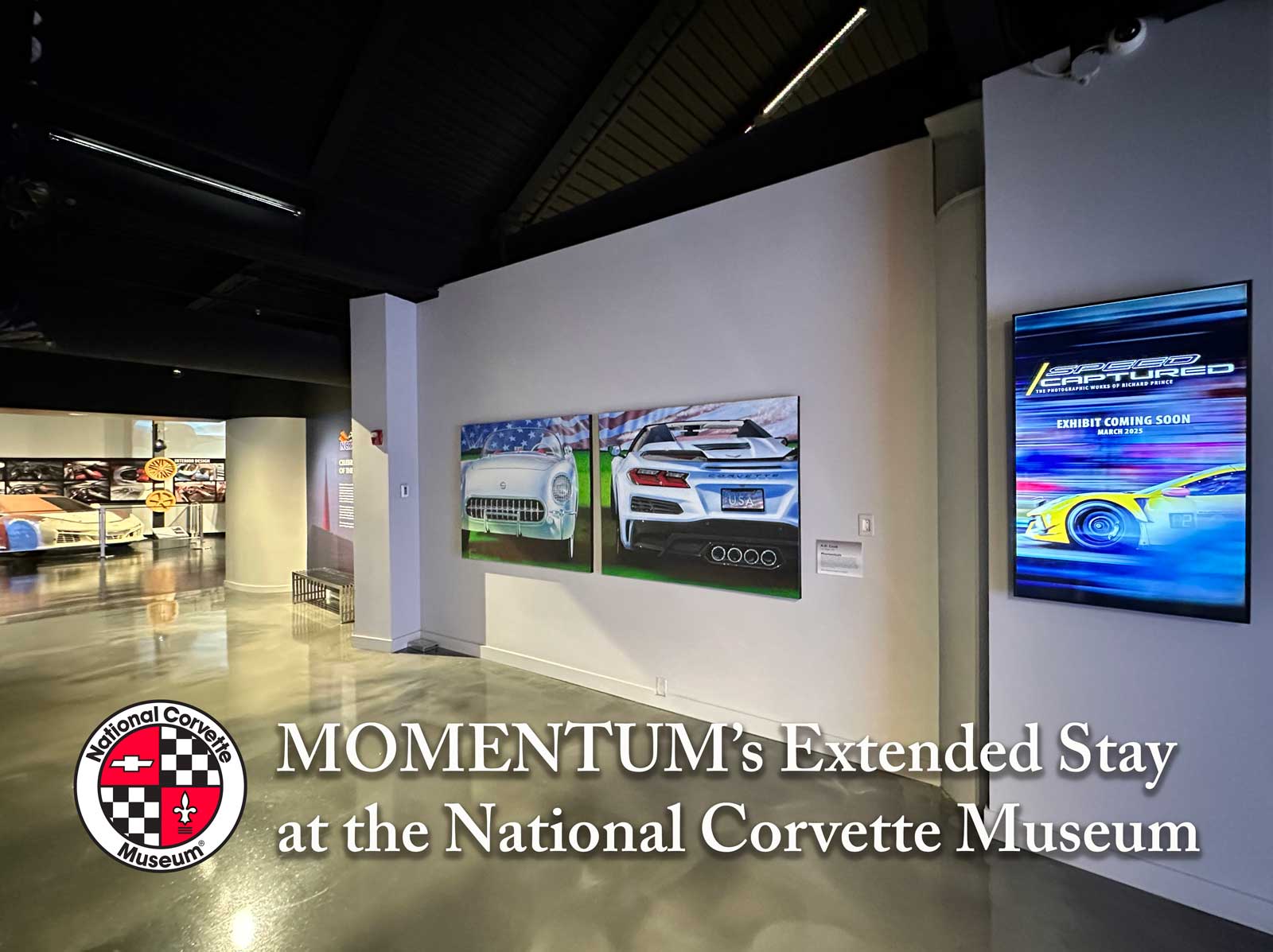 \A.D. — Well, currently at the National Corvette Museum is my painting, MOMENTUM, which features a 1953 and a 2023 Corvette. They were part of LUSTER, but they stayed behind when LUSTER moved on because they were only created for the Corvette Museum part of the show, but they’re on extended stay there. And then I was in a big show in Portland, Oregon, featuring airbrush artists, including the old crew, and I used to be in a lot of galleries, but I’m not currently showing in any galleries.
\A.D. — Well, currently at the National Corvette Museum is my painting, MOMENTUM, which features a 1953 and a 2023 Corvette. They were part of LUSTER, but they stayed behind when LUSTER moved on because they were only created for the Corvette Museum part of the show, but they’re on extended stay there. And then I was in a big show in Portland, Oregon, featuring airbrush artists, including the old crew, and I used to be in a lot of galleries, but I’m not currently showing in any galleries.
BRYAN — Okay. Do you have a gallery that represents you, or are you your own salesperson?
A.D. — I’m right here. Okay. Do everything. I like it that way. I no longer need a large crew or staff. I’m not really in that mode anymore. So, I don’t want to manage people; I enjoy creating the art. It’s more important to me that I enjoy it than anything.
BRYAN — Are there any shows you’re participating in down the line, or something you’re thinking of, or just taking it as things come up?
A.D. — I’m just sort of, at this point, figuring it out. I moved to Phoenix about a year ago. So, I’m reconnecting, or rather, reconnecting with the car world down here. I attend many car shows and meet a lot of people, and we discuss various topics here and there, but nothing substantial has been established yet—just establishing myself in this part of the world.
BRYAN — Nice. Yes, it’s a very different climate out in the desert compared to the Pacific Northwest.
A.D. — Well, I was in Vegas for the last eighteen years, so the climate is different, but the availability of venues and everything, that’s hugely different.
BRYAN — I grew up along the West Coast myself and then moved out here a couple of different times to the southwest, but I’ve been here in Las Cruces for almost a decade now. And yeah, I like it out here. I like it in New Mexico, as well as out in Arizona, particularly in Phoenix.
A.D. — Well, Las Cruces is beautiful. I enjoyed my visit. That was beautiful.
BRYAN — Thank you. And, for our audience, if you’re not aware, a few weeks ago at the artist reception for Luster, A.D. was one of four artists who visited us and participated in a group discussion about the exhibit and their work. The other artists included Cheryl Kelly, Mark Jones, and John Schaefer. So, yeah, we’re working on having a video of the talk available on our social media, hopefully pretty soon. Stay tuned for that [NOTE: the artist group discussion is now live on FB], and as I mentioned before, we will also post our talk with A.D. today on social media at Facebook.com/LCMuseums.
So, yeah, I haven’t seen any other questions or comments coming in. We touched on this briefly, A.D. So you have your website ADCook.com. So is that right? Okay. So, if someone wanted to reach out to you with questions or about your art, would that be the best place to contact you, such as through your website? Do you have social media?
A.D. — Yeah, the website is good, and then if you scroll down to the bottom on any page, it has all my social media, Facebook, Instagram, and X (formerly Twitter). And I’m reachable through pretty much most of those. I favor Instagram just because it’s easy. It’s very visual, in and out. I try not to get lost on Facebook too often because it’s easy to go down the rabbit hole.
BRYAN — Okay, everybody, so A.D., do you have any final comments or remarks before we wrap up for today?
A.D. — I appreciate our time together and being part of the Luster experience at the Las Cruces Museum. I think that’s just really beautiful. You guys did a fabulous job outlining it.
I’m looking forward to picking up my Jaguar there (my all-time favorite car).
BRYAN — That’s something, too. So, yeah. One unique aspect of our exhibition here at the museum is that a local car collector has loaned us his 1967 Jaguar, which is currently on display in the middle of our gallery.
A.D. — It’s pristine. It’s gorgeous. Yes, if you’d like to come check it out, but come for the art. As I mentioned earlier, Luster will be here through Saturday, August 16th. So, you have just about two months left to see the exhibit, and then that will be it. Everything goes back, and you know we’re the final stop here. So, thank you again. All right. All right. Well, A.D., thank you so much for your time. It’s been a pleasure talking to you again. As I mentioned earlier, please keep an eye on our social media for the recording of this video. If you’d like to reach out to A.D. again, please check out his website at ADCook.com. I hope everyone has an excellent rest of their morning, afternoon, or evening, wherever they’re tuning in from.
We look forward to seeing you at the following program. So A.D., thanks again so much.
A.D. — Thank you, Bryan.
BRYAN — Thank you all. All right, everybody. Bye.
Special thanks to Bryan Lee. Video © 2025 Las Cruces Museum of Art. Transcribed by A.D. Cook. Edited for clarity.
- About the Author
- Latest Posts
- More info
A.D. is an artist who started drawing at a young age. Throughout his life, he has worked with different creative tools in traditional and digital art and design. His art and writings have been showcased in various publications such as Airbrush Action Magazine, Airbrush Magazine, American Art Collector, Art & Beyond, Dream To Launch, Easyriders, Las Vegas City Life, Las Vegas Weekly, L’Vegue, ModelsMania, Quick Throttle, and The Ultimate Airbrush Handbook.

